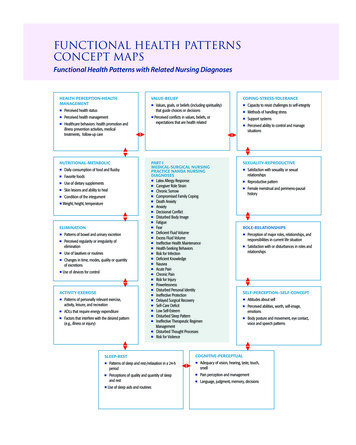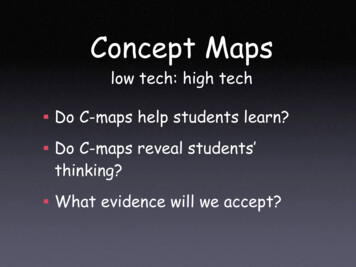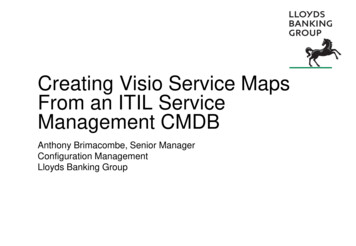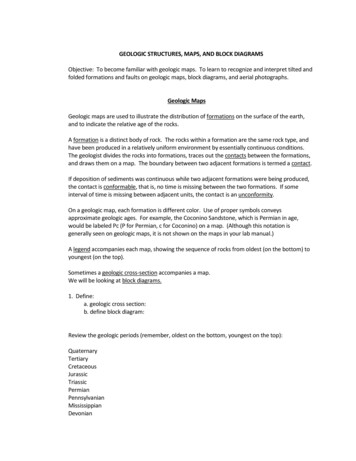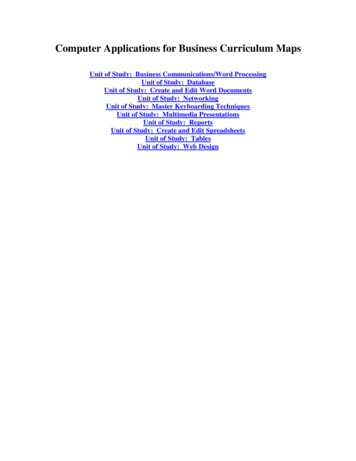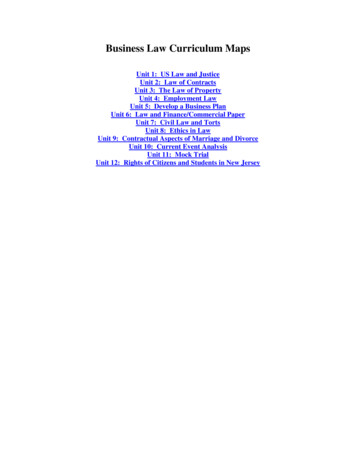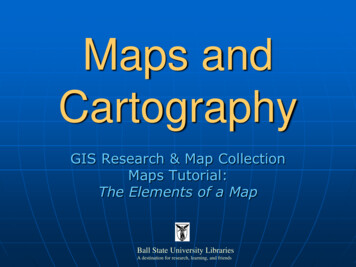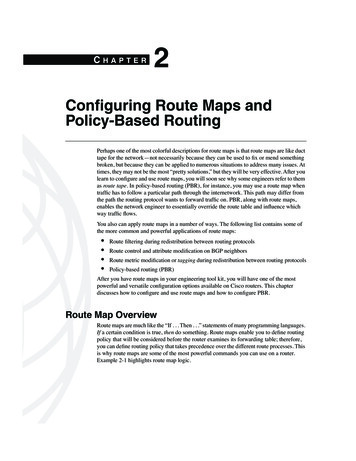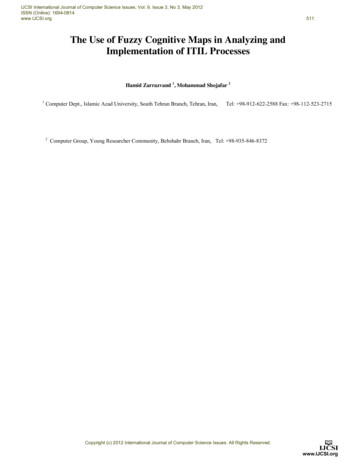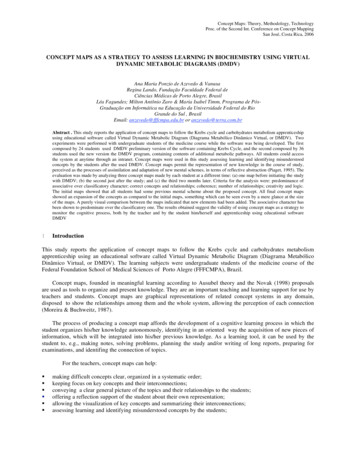
Transcription
Concept Maps: Theory, Methodology, TechnologyProc. of the Second Int. Conference on Concept MappingSan José, Costa Rica, 2006CONCEPT MAPS AS A STRATEGY TO ASSESS LEARNING IN BIOCHEMISTRY USING VIRTUALDYNAMIC METABOLIC DIAGRAMS (DMDV)Ana Maria Ponzio de Azevedo & VanusaRegina Lando, Fundação Faculdade Federal deCiências Médicas de Porto Alegre, BrasilLéa Fagundes; Milton Antônio Zaro & Maria Isabel Timm, Programa de PósGraduação em Informática na Educação da Universidade Federal do RioGrande do Sul , BrasilEmail: anzevedo@fffcmpa.edu.br or anzevedo@terra.com.brAbstract . This study reports the application of concept maps to follow the Krebs cycle and carbohydrates metabolism apprenticeshipusing educational software called Virtual Dynamic Metabolic Diagram (Diagrama Metabólico Dinâmico Virtual, or DMDV). Twoexperiments were performed with undergraduate students of the medicine course while the software was being developed. The firstcomposed by 24 students used DMDV preliminary version of the software containing Krebs Cycle, and the second composed by 36students used the new version the DMDV program, containing contents of additional metabolic pathways. All students could accessthe system at anytime through an intranet. Concept maps were used in this study assessing learning and identifying misunderstoodconcepts by the students after the used DMDV. Concept maps permit the representation of new knowledge in the course of study,perceived as the processes of assimilation and adaptation of new mental schemes, in terms of reflective abstraction (Piaget, 1995). Theevaluation was made by analyzing three concept maps made by each student at a different time: (a) one map before initiating the studywith DMDV; (b) the second just after the study; and (c) the third two months later. Criteria for the analysis were: predominance ofassociative over classificatory character; correct concepts and relationships; coherence; number of relationships; creativity and logic.The initial maps showed that all students had some previous mental scheme about the proposed concept. All final concept mapsshowed an expansion of the concepts as compared to the initial maps, something which can be seen even by a mere glance at the sizeof the maps. A purely visual comparison between the maps indicated that new elements had been added. The associative character hasbeen shown to predominate over the classificatory one. The results obtained suggest the validity of using concept maps as a strategy tomonitor the cognitive process, both by the teacher and by the student him/herself and apprenticeship using educational softwareDMDV1IntroductionThis study reports the application of concept maps to follow the Krebs cycle and carbohydrates metabolismapprenticeship using an educational software called Virtual Dynamic Metabolic Diagram (Diagrama MetabólicoDinâmico Virtual, or DMDV). The learning subjects were undergraduate students of the medicine course of theFederal Foundation School of Medical Sciences of Porto Alegre (FFFCMPA), Brazil.Concept maps, founded in meaningful learning according to Ausubel theory and the Novak (1998) proposalsare used as tools to organize and present knowledge. They are an important teaching and learning support for use byteachers and students. Concept maps are graphical representations of related concept systems in any domain,disposed to show the relationships among them and the whole system, allowing the perception of each connection(Moreira & Buchweitz, 1987).The process of producing a concept map affords the development of a cognitive learning process in which thestudent organizes his/her knowledge autonomously, identifying in an oriented way the acquisition of new pieces ofinformation, which will be integrated into his/her previous knowledge. As a learning tool, it can be used by thestudent to, e.g., making notes, solving problems, planning the study and/or writing of long reports, preparing forexaminations, and identifing the connection of topics.For the teachers, concept maps can help: making difficult concepts clear, organized in a systematic order;keeping focus on key concepts and their interconnections;conveying a clear general picture of the topics and their relationships to the students;offering a reflection support of the student about their own representation;allowing the visualization of key concepts and summarizing their interconnections;assessing learning and identifying misunderstood concepts by the students;
evaluating the teaching process;evaluating the attainment of goals by the students through the identification of misunderstood and missingconcepts.An example of the use of concept maps in Biochemistry can be found in Campbell (2000). At the beginningof each chapter, the author presents a concept map of the topics that will be dealt with therein, characterizing animportant reading support tool. Another example in Biochemistry it is in a book by Richard Harvey and PamelaChampe (2005). Since students often view Biochemistry as a pile of facts or equations to be memorized rather thanas concepts to be understood, these authors created a series of concept maps about the biochemical contents toillustrate graphically the relationships between the ideas presented in a given chapter, as well as to show howinformation can be grouped or organized. For these authors a concept map can be used as a tool by a studenthim/herself to visualize the connections between the concepts. Differently from the educators who define conceptsas perceived consistencies in events or objects, these authors understand concepts in biochemical concept maps asabstractions (e.g. free energy), processes (e.g. oxidative phosphorylation), and compounds (e.g. glucose-6phosphate).According to Jean Piaget the development of the human cognitive process, the building of concepts is asystem in which their elements are necessarily supported on one another, while at the same time being open tomultiple exchanges with the outside. It is thus assumed that it is impossible to build a single concept A as a startingpoint in a classification without using other domain-related concepts, which characterizes a non-hierarchical,dynamic process of interconnected variables. According to Dutra, Fagundes and Cañas (2004)1: “(.) in the dynamicof making a concept map one can follow the representation of a system of meanings activated in an individual sothat in it we also recognize subsystems that relate to one another by mutual support in the building of suchmeanings".In the present work, concept maps have been used as tools to represent knowledge, from an instrumentalpoint of view, i.e., as a tool to support students' and even teachers' expression. From the conceptual point of view,they were used according to the Piagetian view of concepts formation, described by Dutra, Fagundes and Cañas(2004). This means that these instruments have been given the ability to represent systems of preexisting meaningsin students, as well as activation of later constructions, and possible subsystems of signification associated with theconcepts of the content at issue. By the analysis of concepts and linking sentences made by the student, we aimed toascertain (1) the student's knowledge of the studied topic, (2) the influence of the use of the educational software,and (3) how the student would represent his knowledge two months after completion of the study.Concept maps focus on aspects relating to the conceptual structure of content, and therefore they wereconsidered as instrumental for evaluation purposes, so as to add conceptual and pedagogical value to the traditionalforms of evaluation, i.e. through tests. This stance is supported by various authors who have done research onconcepts maps as a support of teaching activities. According to Farias (1995, p. 23), “(.) for a student to elaborate acorrect concept map, he/she must have a wide understanding of the studied material, differentiating between moregeneral concepts and the various levels of subordinate concepts". This view had been previously presented byStewart, Van Kirk and Rowel (1979 apud Farias, 1995), who think that concept maps appear to evaluate student'sknowledge more effectively than other evaluation tools, because they depict the structure of the studied content.In order to facilitate the student’s understanding of the metabolic pathways and provide greater interactionwith the contents and thus better learning an software, called Virtual Dynamic Metabolic Diagram, was developedwhich allows the user to learn, study, and review contents concerning Krebs Cycle and carbohydrate metabolismthrough:1a.interactive games with a string of substrates and enzymes of the metabolic pathways, their control,inhibition, role of vitamins in their correct functioning, and their connection with other systems;b.readings on the functions and characteristics of metabolic pathways, as well as historical milestonesalong their development;c.solving of essay and multiple-choice questions.Electronic document, referenced at the end of this paper.
2MethodsAfter the pilot trials in using the preliminary version of the software containing Krebs Cycle, reported in Azevedo,(2003; 2003a and 2004), a second trial with a new version of the software containing contents of other metabolicpathways. The software was evaluated by two groups of undergraduate students regularly enrolled in the disciplineof biochemistry. All students could use the software for studing during two classes in a computer room. In thefollowing week, before the evaluation of the discipline concerning this topic, the software was made available againthrough the intranet of the institution. All students were registered on the system, and their access, through use of apersonal password, allowed the recording of activities on an individual basis.Two groups of students were tested on the application of concept maps as a tool to assess learning after theuse of the DMDV software educational for the Krebs cycle and carbohydrates metabolism. While the first groupused concept maps to depict their knowledge of the Krebs Cycle, the second group worked with a wider content,including the Krebs Cycle as well as Carbohydrates Metabolism. The content didn’t work in the expositive class,only in the software that make possible a comprehensive student interaction, making possible the initiative andautonomy of the student during the activity. The software makes possible the student action with the logic sequencegame, to do the metabolic route, and with the classmates, to access new information through the hypertexts,available in the virtual environment or in the internet, or still to consult texts or printed books. This experience wasrealized with the target that the students did a activity of concept’ contrution and no to repeat the expositives classinformations. The construction of a concept map permits the representation of knowledge during the study,perceived as the processes of assimilation and adaptation of new mental schemes, in terms of reflective abstraction(Piaget, 1995). The evaluation was made by analyzing three conceptual maps made by each student: (a) one mapbefore initiating the study with the DMDV; (b) the second just after the study and; (c) the third two months later.This analysis used the following criteria: predominance of associative over classificatory character; correct conceptsand relationships; coherence; number of relationships; creativity and logic.3Analysis of Concept MapsSome general observations about the concept maps of all participants can be made from an analysis of the whole.The initial maps indicate that all students had some previous knowledge of the proposed concept. All final conceptmaps showed an expansion of the concepts as compared to the initial maps, something which can be seen even by amere glance at the size of the maps. A purely visual comparison between the maps indicated that new elements hadbeen added. Some initial maps presented few concepts and relations. A purely visual comparison between the mapsindicated that new elements had been added, reinforcing the opportunity of using concept maps in the learningprocess.Students with less previous knowledge (fewer representations in the initial map) presented more expansionon the final map (showing changes that occurred in the students' previous ability to represent).With rare exceptions, both the initial and the final map of all participants were coherent, cohesive,expressive and logic.The maps also showed another characteristic that is desirable for the teaching-learning process: theinterrelation of concepts, so that they are not characterized as fragments but as parts of a whole, whoseinterconnections are crucial for understanding the content in its more complex sense, which includes generalizations,abstractions and content disposition by order of relevance and meaning. For example, on the third concept map, theconcepts of relations with the synthesis of urea, function of the cycle, and control were more associated, which givesa perfect idea of the insertion of the concept in a contextual whole show examples of these relations in the maps oftwo students). On the second map, in addition to function, location and characteristics, there appeared the list ofnames of substrates, concepts that are related to structured memory. An analysis of the relations between theconcepts depicted on students' concept maps shows that these concepts were better understood. Interestingly, thefirst maps often presented the word "is" to indicate a relation, while the two later maps indicated relations usingwords like "oxidizes", "yields", and "synthesizes", etc.
All maps included concepts related to function, location and characteristics of the metabolic cycle. Thesecond map also showed the names of the substrates and enzymes of the cycles, which seems to suggestenhancement of memorization soon after using the computer program.Besides
Concept Map s: Theory, Meth odology, Technology Proc. of th e Second Int. Conference on Concept Mapping San José, Costa Rica, 2006 CONCEPT MAPS AS A STRATEGY TO ASSESS LEARNING IN BIOCHEMISTRY USING VIRTUAL DYNAMIC METABOLIC DIAGRAMS (DMDV) Ana Maria Ponzio de Azevedo & Vanusa Regina Lando, Fundação Faculdade Federal de Ciências Médicas de Porto
